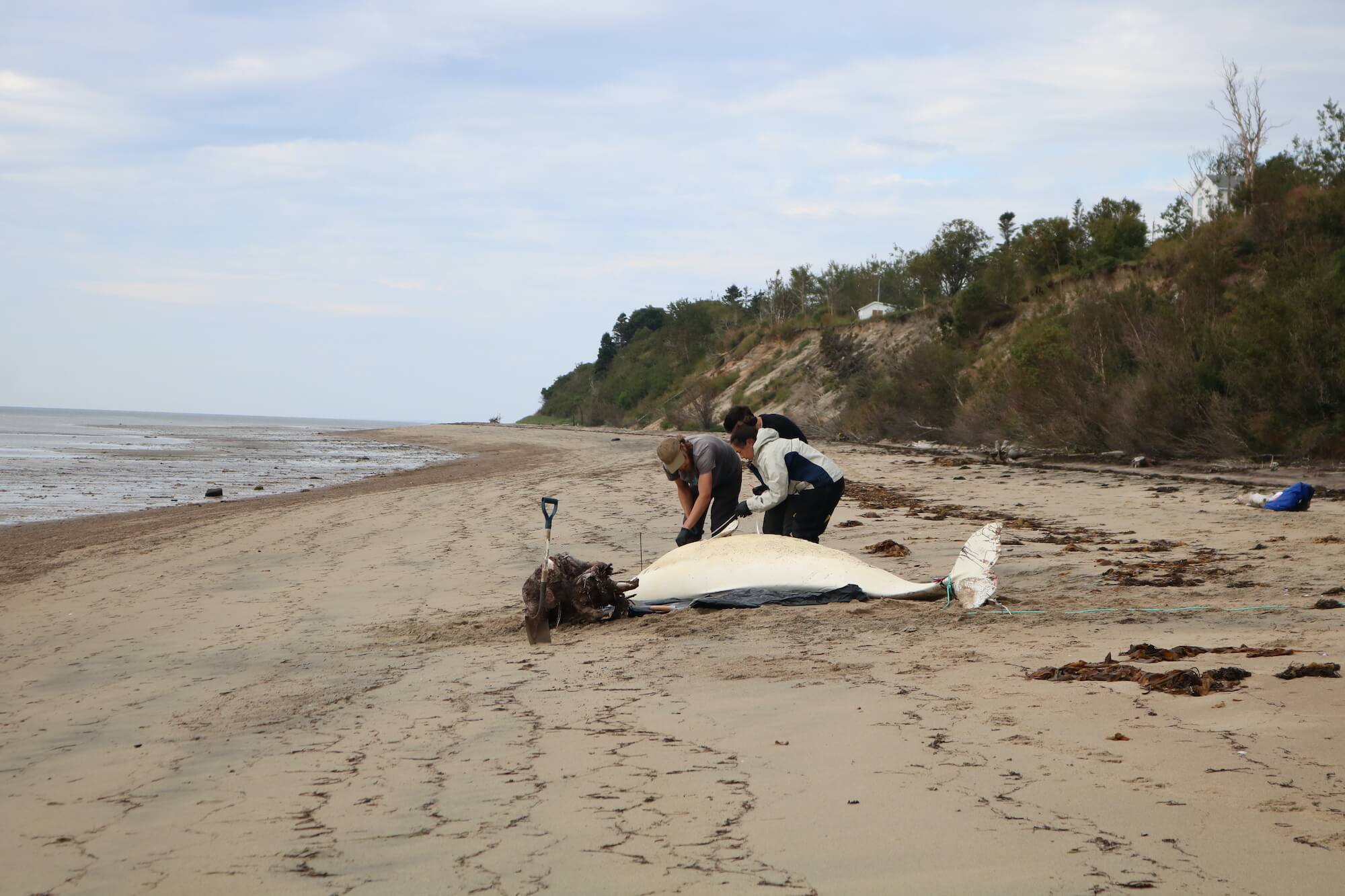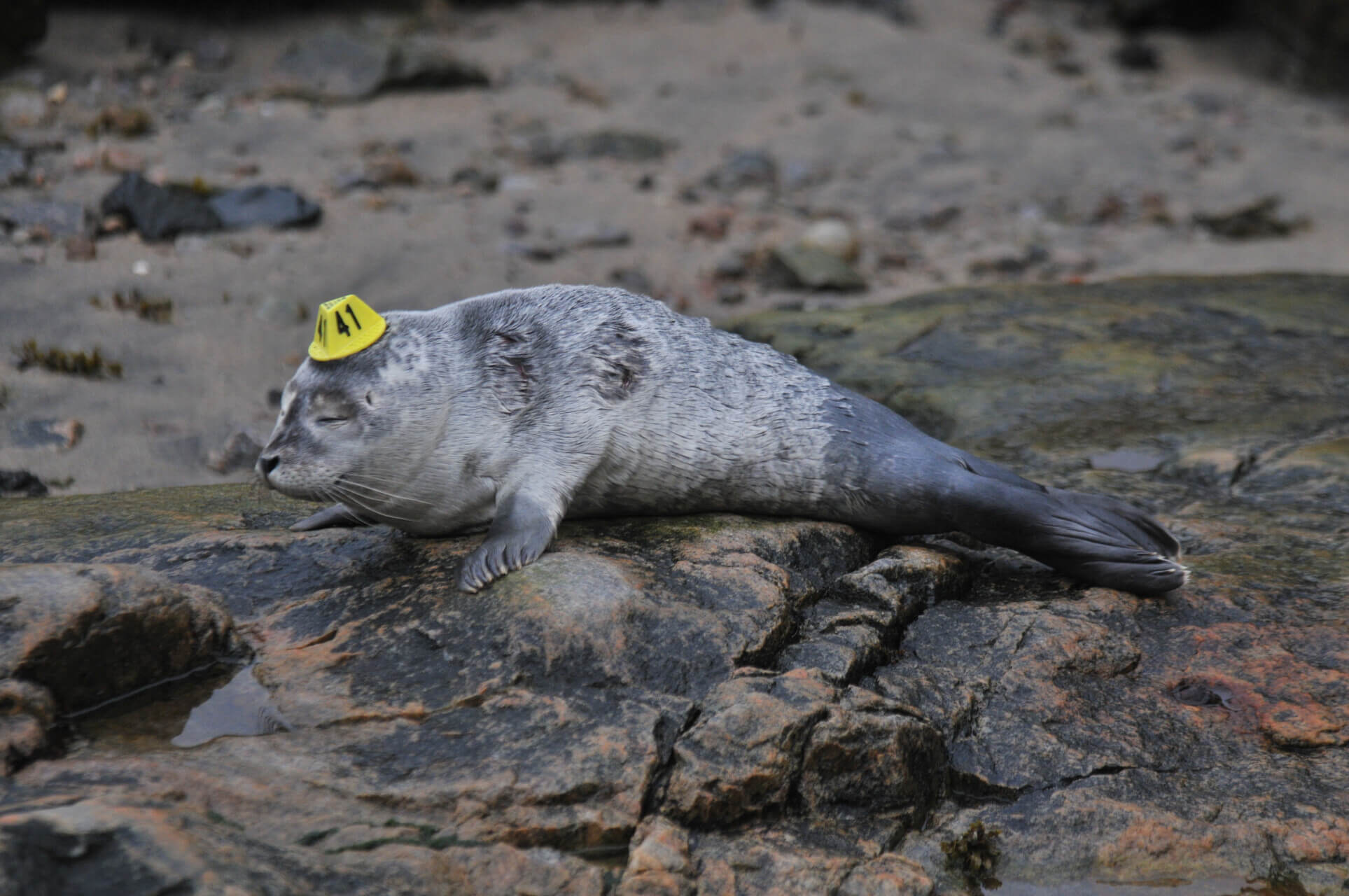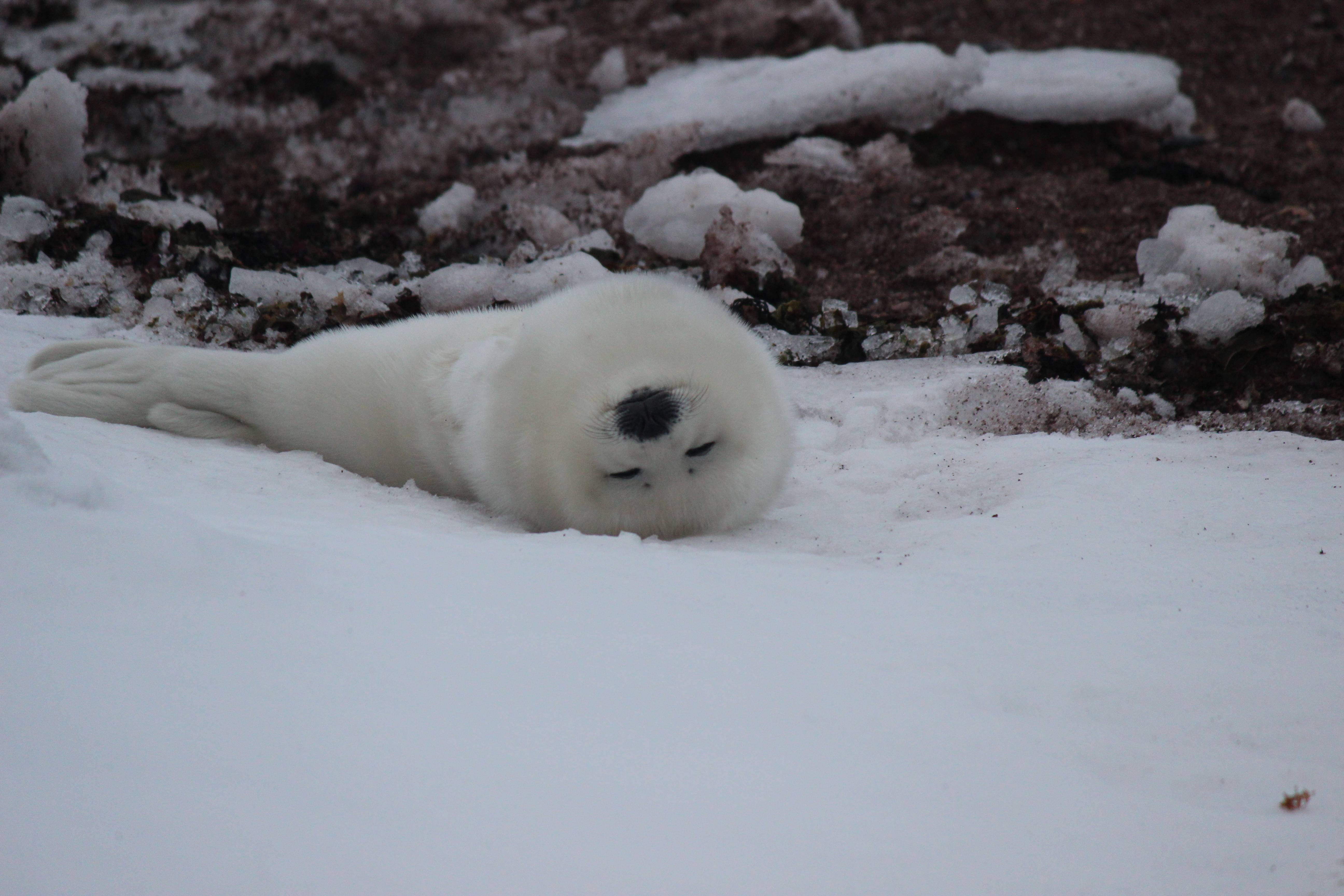News: September 18, 2015: Fisheries and Oceans Canada reminds the public not to interact with the beluga
We haven’t heard anything in several weeks about the belugas observed this summer in Rhode Island and Nova Scotia (including the one observed on August 11 in Cape Breton, which was one of the three individuals seen in Rhode Island). However, another solitary beluga has been seen in Grates Cove, Newfoundland since the beginning of September. Unlike the animals of Nova Scotia and the East Coast of the US, this individual is very sociable with boaters and divers, which is quite concerning, especially with regard to the risk of collision. Divers have even approached it and tried to touch it. Fisheries and Oceans Canada recalls that it is illegal to disturb a marine mammal and that this behaviour can harm the animal. If it gets accustomed to interactions with humans, the risk of collisions with boats may increase.
Where might it have come from? In the past, most belugas seen in Newfoundland were from populations in northern Quebec, while those spotted in the United States and the Maritimes came mainly from the St. Lawrence population. Despite these data, the origin of the Grates Cove beluga remains open to debate, as only a small percentage of vagrant beluga cases have been analyzed to date. To determine the origin of an out-of-range beluga, biopsies or photo-identification are used.
These instances of emigration are intriguing for Quebec researchers. What do these large wanderings mean for a declining population such as that of the St. Lawrence? To better understand the long-term impact of these beluga vagrancies, and to find out where these stray individuals come from, additional research efforts will be made to monitor these animals far from home.
Summary of the story of the hour:
In mid-May, three belugas are found “on the run” in Narragansett Bay in Rhode Island. Photos taken by research teams on site confirm that one of the three belugas is “known”. This young gray beluga had been sighted two years earlier, on July 2, 2013, in the St. Lawrence Estuary. In early June, a fourth beluga is observed in Nova Scotia’s Eastern Passage region. Since then, it has travelled from the port of Halifax to Liverpool and later to Aspotogan Cove. Analysis of a biopsy sample taken from its back has since indicated that it belongs to the St. Lawrence population. August 11: a beluga is spotted off the tip of Cape Breton, Nova Scotia; it is one of the belugas that had been seen in mid-May in Rhode Island… possibly on its way back home! As of early September, nothing has been reported on the belugas seen in Rhode Island and Nova Scotia. However, they are not the only “globetrotters”! Two belugas were sighted in northern England recently, as was one beluga in Newfoundland.
Follow the story of these remarkable observations
- Two belugas were spotted in northern England
- Belugas in Nova Scotia
- Three whales “on the run” in the US
Two belugas were spotted in northern England
September 8, 2015: Belugas “on the run” in the Atlantic: not the only globetrotters!
The St. Lawrence belugas observed this summer on the East Coast of the United States and Nova Scotia are not the only ones to have strayed far from their usual range. In early September, two belugas were spotted near the coast of Northumberland, off the northeastern tip of England. Where could they possibly have come from? The closest beluga populations are found in Greenland or in the Barents Sea.
Although rare, this was not the first such sighting in this region. According to the Sea Watch Foundation, 17 beluga observations have been recorded in British and Irish waters over the past 30 years.
To learn more: Beluga whales spotted off Northumberland coast
August 21: Two whales are sighted in Ingonish (Nova Scotia)
New sightings were reported on August 18 to the MARS team (Marine Animal Response Society): two belugas were seen near Ingonish, Nova Scotia. Researchers are wondering, might they be the two other belugas seen earlier in the United States (one of the three belugas sighted in the US was seen again on August 11 in Pleasant Bay)? Or perhaps is it the beluga nicknamed “Luke” in the company of another individual? For the time being no photos have been taken that might provide additional clues.
August 13, 2015: Cape Breton Beluga Possibly Heading Back to St. Lawrence
New photos transmitted by the lab of Hal Whitehead have helped identify the Cape Breton visitor: it is one of the three belugas spotted earlier in May in Rhode Island and later in Long Island Sound and New Jersey. We hadn’t heard anything about these three belugas since May 30. This new observation suggests that at least one of the three individuals has survived. It might be on its way back to its usual habitat… the St. Lawrence Estuary.
To be continued…
August 11, 2015: A second beluga is spotted off the tip of Cape Breton
It was sighted by the crew of a whale-watching cruise out of Pleasant Bay, a few nautical miles from Skyline Trail in Cape Breton Highlands National Park. The animal was very sociable. The boat cautiously distanced itself from the animal. Photos were taken by students working under researcher Hal Whitehead, who are pursuing research projects on pilot whales in the region. These photos have been sent to the GREMM team in an attempt to determine whether or not this beluga belongs to the St. Lawrence population. Thanks to the photos, researchers have confirmed that it is indeed one of the three St. Lawrence belugas seen earlier this summer on the eastern US seaboard.
August 10, 2015: Beluga “Luke” Observed for Nearly a Week in Aspotogan Cove Area
Since August 2, the beluga nicknamed “Luke” has been observed daily in the Aspotogan Cove sector (located in the Aspotogan Peninsula on the southern coast of Nova Scotia). This cove is rich in prey including mackerel and squid. The following photo shows “Luke” in front of the salmon trap temporarily installed in the cove for aquaculture purposes
August 3, 2015: High turnout at evening information session for the beluga “Luke” observed in Nova Scotia
Nearly 200 people attended the evening information briefing in Liverpool on the situation of the lone beluga “Luke”, who owes his nickname to the species’ Latin name Delphinapterus leucas.
This beluga has been attracting public attention. Solitary and outside of its normal range, it has been developing a social and curious behaviour toward humans, approaching boats on the water. During the evening, specialists took the time to explain this behaviour and the associated risks and reported on what to do in the presence of the animal in order to protect it.
July 21: Evening conference to raise awareness of the Liverpool beluga
The latest information concerning the Liverpool beluga indicates that the animal has been regularly approaching kayakers in the area. To raise public awareness about the situation of this solitary male beluga, the team of specialists in place decided to organize an information session for local citizens entitled “The Charm & Challenge of a Lone Beluga Whale” on the evening of July 28.
July 13: Answers to the identity of the beluga through biopsy
The beluga seen in the Liverpool area in Nova Scotia is a male and there is a good chance that he belongs to the St. Lawrence population. These results were obtained in the analyses conducted by the team of Tim Frasier of Halifax’s Saint Mary’s University on the skin sample collected for biopsy.
July 9: meeting held to assess the beluga seen near Liverpool
On July 8, members of various organizations (Fisheries and Oceans Canada (DFO), the Marine Animal Response Society (MARS), the Whale Stewardship Project and the GREMM) met to discuss the beluga seen in the Liverpool region of Nova Scotia.
Screenshot (Google Maps): The animal was last seen on July 6 near Fort Point. It does not seem to approach motorized watercraft, though it was seen near kayakers and windsurfers. It is in an area where shipping traffic is quite high. The animal appears to be around 8 to 10 years old.
A biopsy was taken on June 24. The sample has been sent for analysis by the University of Saint Mary’s in Halifax. With this sample, it will be possible to determine whether the animal belongs to the St. Lawrence population. All animals sighted in areas far to the south of the St. Lawrence population that were identified by photo-ID or biopsy have belonged to this population.
June 24: the beluga seen in Halifax has reached Liverpool and the biopsy is successful!
The wandering beluga observed in the port of Halifax earlier this month has been present for over a week in the port of Liverpool, Nova Scotia. This municipality is located on the province’s southern coast near the mouth of the River Mersey.
Researchers from the Marine Animal Response Society (MARS), in collaboration with a team from Fisheries and Oceans Canada, took photos and sent them to the GREMM team. The animal was not identified.
American researchers are trying to take a biopsy of the individual to determine whether it belongs to the population of the St. Lawrence. Moreover, the GREMM team has provided a biopsy kit, including a crossbow, so that the biopsy can be attempted from a distance. The biopsy was successfully performed on June 24.
June 1: a fourth beluga far from the others
The Group for Research and Education on Marine Mammals (GREMM) was notified on May 28 that a beluga had been seen in the Eastern Passage area in Nova Scotia. The following day, photos confirm its presence in the port of Halifax. Researchers from the Marine Animal Response Society (MARS), in collaboration with a team from Fisheries and Oceans Canada, attempt to locate the animal. They hope to obtain quality photos to enable an identification, as well as a biopsy that would determine whether the beluga belongs to the St. Lawrence population. In vain. It’s not until the next day that the beluga is spotted again, early in the morning in the area of Terence Bay, but no intervention is attempted.
The most recent update received early Monday afternoon indicates that the beluga was not reported over the weekend until Sunday night, when it is said to have been sighted at 5 pm near Bayswater Beach. Several local media outlets reported the news; response teams are hopeful that this coverage will help to gather information on the animal’s subsequent movements.
In the same vein, news of the three stray belugas in the United States were transmitted to GREMM researchers: they are still present in the New York area, specifically in the Long Island Sound region.
A Beluga “Gone Astray” in the US
July 21, 2015: last observations of the beluga trio in the US
The last confirmed sightings were made on May 30, 2015. At the time the animals were in the area of Sandy Hook Bay, New Jersey; this was the most southerly observation since monitoring had begun. On June 6, belugas are reported to have been sighted in the northern portion of Long Island Sound, though these observations could not be confirmed. Since then, no further news has been received.
May 25, 2015: change of direction to the south and feeding caught on video
The three young belugas have now reached the Long Island region. Several employees from the National Oceanic and Atmospheric Administration (NOAA) followed them closely all of last weekend, which happened to be Memorial Day weekend. Researchers were concerned about increased traffic during this ederal holiday in the US. A number of awareness campaigns were conducted with the public in an effort to reduce the risks of collision and harassment.
On the other hand, the NOAA team indicates that it has observed the belugas engaged in feeding behaviour since it began monitoring. However, it has just received the first video recording of this feeding behaviour, which shows belugas bringing their catches of summer flounder up to the surface. Summer flounder are large flatfish found from Nova Scotia to South Carolina.
May 20, 2015: biopsies
On May 15, a team from the National Oceanic and Atmospheric Administration (NOAA), assisted by members of Mystic Aquarium and the Animal Rescue Team, collected biopsies from three belugas present in Narragansett Bay. These skin and fat samples will unveil details about the state of health and the genetic origin of these young belugas.
A few days earlier, one of the three individuals was recognized by the GREMM team as a St. Lawrence beluga. The other two animals have still not been identified, but it is very possible that they also belong to this declining population.
To learn more: Press release from NOAA
May 15, 2015: one individual recognized
With photos sent by the Mystic Aquarium team, the GREMM was able to compare these images of the stray belugas in Narragansett Bay with those in the St. Lawrence beluga catalogue. One of the three belugas was recognized. This young gray beluga had been sighted two years earlier, on July 2, 2013, in the heart of the St. Lawrence. At that time it was in a large herd of young belugas near Île Rouge. It has a pronounced gash on his back. Being young – probably under the age of 10 – it does not yet have a code.
The other two belugas have not yet been identified. Check out the photos and a video of the belugas taken by the Mystic Aquarium team.
May 14, 2015: surprising but not exceptional
They were first seen on May 9 in Narragansett Bay in Rhode Island. On May 11, they were spotted again near the town of Warwick. Since then, members of the Mystic Aquarium team have been closely monitoring these belugas. They have sent field documentation, photos and videos to the GREMM team in Quebec. The latter has been attempting to photo-ID the belugas to determine whether they are known in the St. Lawrence. The gray colour and size of these three individuals suggest that they are young animals, probably under 10 years of age.
Photos: Beluga whales “on the run” and the Mystic Aquarium team observing them
These observations in the eastern US are surprising, but not exceptional. In July 2014, one beluga, possibly two, had been seen in the same region. In 2005, the beluga Hélis left the St. Lawrence during the winter and reached the Delaware River in New Jersey, 200 km from the Atlantic coast. A few days later, it reappeared in the Schuylkill River near Philadelphia. It was never to be seen again after that.
The southernmost beluga population is that of the St. Lawrence. This population is isolated from other Arctic populations and distinct from a genetic standpoint. The other populations are only found in the northern hemisphere, in circumpolar regions lying between the 50th and 80th parallels.
These instances of emigration are intriguing for Quebec researchers. What do these large wanderings mean for a declining population such as that of the St. Lawrence? Only about 900 belugas are believed to remain in the St. Lawrence. The Committee on the Status of Endangered Wildlife in Canada (COSEWIC) designated the St. Lawrence beluga population as “endangered” in December 2014.
Here’s a video (© Mystic Aquarium):





